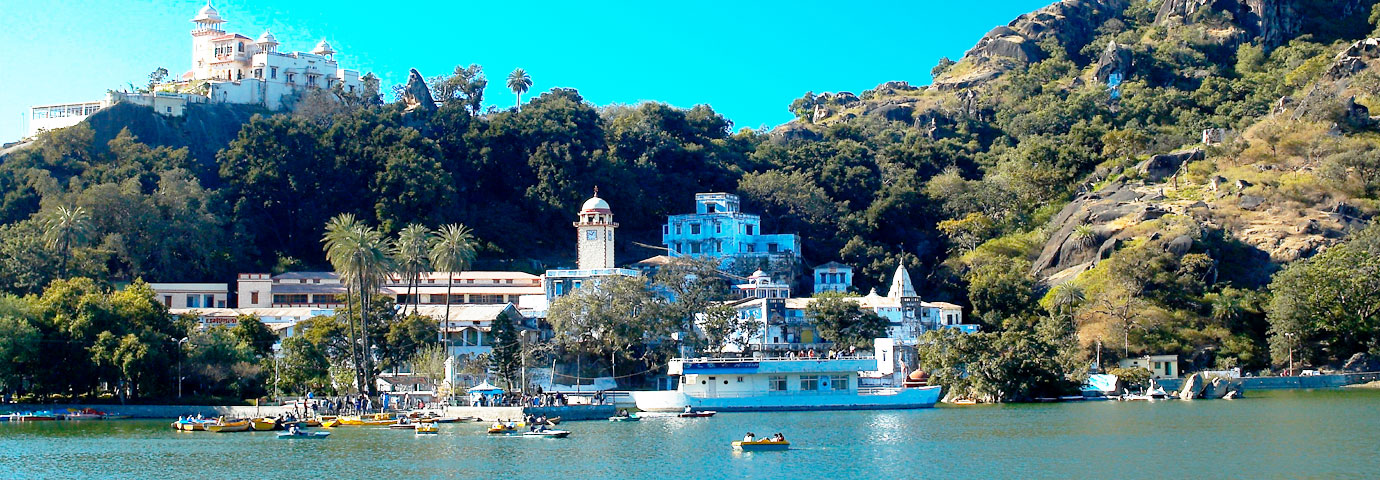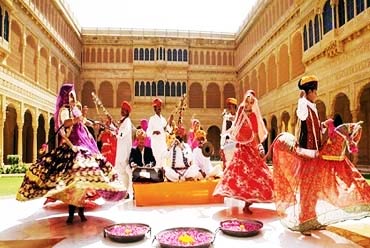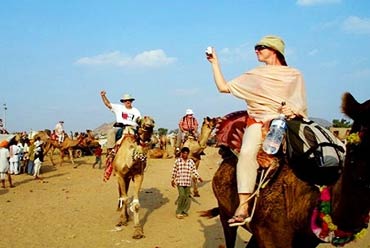Mount Abu is one of the popular jain pilgrimage sites. The road to paradise has never been easy and this one is no exception. Bumping along an uneven road, hitting your head against the smooth roof of a deluxe bus you need to close your eyes and revive the temptations of your destination. Conjure up the lushness of Mount Abu, which all tourist guides announce is 'the paradise of Rajasthan'.
The little pamphlet gushes that Mount Abu, the only hill station in Rajasthan, offers you the best of all possible worlds, with more scenic beauty, more architecture and archaeology in the form of the famous Dilwara caves, the chief center for the Brahmakumaris and a generous peppering of temples which shows that the place is exceptionally favored by the gods. Abu has been an important place of penance for the sages.
Location
As the anticipation of the approaching destination heightens one doesn't mind the shaking bus quite that much and as you turn the final curve into the city, greeted by large hoardings of different hotels, all promising better deals than the other, Rajasthan's little jewel puts its best foot forward. The shops on both sides of the road are glitteringly alive, as late as 10 p.m. on a winter night and the residents of Mount Abu mob you in welcome. Well not exactly the residents it turns out, they are all touts for hotels but they make you feel welcome. In case it is a winter trip that you are planning, one can just arrive in Abu, at any time of the night or day, employ a wheelbarrow, which will take your luggage all over Abu for few rupees while you check out a place to stay. This is, in fact the best time to visit if the cold does not bother you too much (it is usually warmer than a Delhi winter). All hotels are available at half rates and the best of rooms can be yours for a rate that suits your budget.
Abu in summer is definitely a retreat from the heat of the plains. A summer visit requires careful planning, and rooms should be booked at least two months in advance. Everything, from hotels to restaurants, to transport is at double the rates, and beware of the new monster - the Marti's, in every color which cover the landscape and race pugnaciously around the hills. Yet, the little township is well prepared to handle tourists. Tourist buses show you around the places of interest twice a day and the bus guide provides a background, history and of course his own interpretations on everything you visit. Information is also available from a tourist guide office, but even without guidance there are certain places that simply cannot be missed on a visit to Abu.
Tourists Attractions
The Dilwara Jain temples for instance, have been compared to the Taj Mahal for their sheer elegance and beauty in marble. Built between the 11th and 13th century, these temples are all the more exceptional because the marble to build these was brought all the way from Makrana and the best workmen and craftsmen employed to ensure the finest quality of sculpture. Intricate carvings decorate each portion of these temples, which are dedicated to the Jain Tirthankaras. Millions of rupees were spent on the carvings, architecture and décor of the temples and the workmen were rewarded in silver and gold equivalent to the amount of marble brought in.
The Jain temple
Of the five temples - Vimal Vasahi, Lun Vasahi, Shri Risha Lhdeo, Shri Parshvanath and Shri Mahavir Swami, the first two are the most famous. One estimate states that a sum of Rs. 1.2 billion was spent on Lun Vasahi itself. This temple was built by two brothers - Vastupal and Tejpal, ministers in the court of Raja Varadnawarkar, a ruler of Gujarat. They belonged to Neminath Bhagwan, the 22nd Tirthankara.
Outside the main doors of this temple, there are two statues called Devrani's and Jethani's goklas respectively, and are backed by stories of competitive jealousy of the two wives of these brothers. Another striking feature of the temple is the marble dome in the porch, which is made up of a cluster of half open lotuses, which appear to be almost transparent.
The Vimal Vasahi temple is older and is also known to be the first Jain temple and is dedicated to the first Jain Tirthankara. Built in 1031, by Bhim Deva, the first Solanki ruler of Gujarat, the temple is constructed in pure marble, with plain exteriors. However, its interiors are richly sculpted and house some fine examples of the accomplishment of artist in those times.
Residents of the area will tell you that a visit to Abu cannot be complete without obtaining the blessings of Arbuda Devi, the goddess after whom Abu is said to have been named. Arbuda Devi is stationed some 200 steps above the road, in a series of caves on top of a mountain. Along with Arbuda Devi are the statues of her three attendants.
Abu's highest peak
Guru Shikhar, the highest peak of Mount Abu, is also perhaps the most beautiful. There is certain serenity about the temple built atop this peak. The temple might just have stepped out of a fairy tale, with only a small portion in pink jutting out of an otherwise plain white chalk building.
Inside is a shrine of Datta-traya, an incarnation of Lord Vishnu. Outside the temple, a little distance from its door is a huge brass bell, which stands sentinel overlooking the lush greenness of Mount Abu. A costume photographer displays dresses and invites tourists to pose with temple as a backdrop.
Another temple worth visiting is the Brahmakhadd, a Shiva temple with a difference. Here the deity is not the traditional lingam but a pit into which Lord Shiva is said to have put his foot. Legend has it that the spot goes deep into the earth until it touches water. Outside this temple there is a statue of Goddess Parvati, and a large statue of Nandi, which still bears marks of destruction, wrought by invading armies.
Nakki, the lake
In the heart of the town, at one end of the Mall is Nakki Lake, which has an interesting history. It is said that it was drawn by the finger nails (nakk) of a sage, Balam Rasia, in response to the demands of the stepmother of the girl he wished to marry. The girl, a princess, and a daughter of the then King of Abu, was also in love with the sage, but because of the evil stepmother the affair ended in tragedy, and has been immortalized in a temple of the Kunwari Kanya, alongside which stands a statue of her lover.
The lake too, has survived to tell the tale. Picturesquely set, with the hills rising all around it, the lake has several islets to which you can hire boats. An interesting facet is the many rock formations around the lake. They have been named Toad Rock, Nun Rock, Nandi Rock and Camel Rock because of their resemblance to these figures. The road appears to be looking broodingly down towards the lake, as if contemplating jumping in. Nun Rock is a large smooth rock, as it supposedly looks a woman with a veil. The climb up to these rocks, through the wooded forests is a beautiful one, with each of the rocks on the way making unique formations, fissures and shapes.
There are rumors that you might run into a bear on your way up, but the climb is well worth the risk! And one can take courage from the fact that none of the travelers in the last few years have encountered the animal.
Places Around Mount Abu
Like all other hill stations, Abu too, has its horse rides, honeymoon and sunset points. Sunset point here is definitely worthy a visit. An entire hill has been carved into several layers, top to bottom and as the sun begins to lower itself in the sky, and the entire hill is crowded with people covered in the golden glow of the setting sun.
How To Reach
Mount Abu is Rajasthan's only hill station. It is 187 km away from Ahmedabad in Gujarat.
By Rail - There are direct trains to Abu Road Station (27 km away from Mount Abu) from Delhi, Jodhpur and Agra. A fast train takes four hours between Ahmedabad in Gujarat and Abu Road.
By Road - Mount Abu is linked with Udaipur and Ahmedabad by road. We would provide you all India tourist permit vehicles for the local transportations and also for the intercity drives too.
Best time to visit Mount Abu
The best time to visit Mount Abu is either during the months of February-June or in between September to December. Though the sole hill station in Rajasthan is a year round destination, these are periods when it is ideal to visit. March to June are the summer months in Mount Abu. Days are hot here but evenings are pleasant. July to October is the monsoon season. Though the city receives less amount of rainfall, the scenic beauty of the hill station is at its peak. November to February is the winter season. Winters are not that extreme, just perfect for sightseeing, outdoor activities and relaxation. The festivals are also a good time to visit as one can indulge in Rajasthani culture, music, dance and food.




